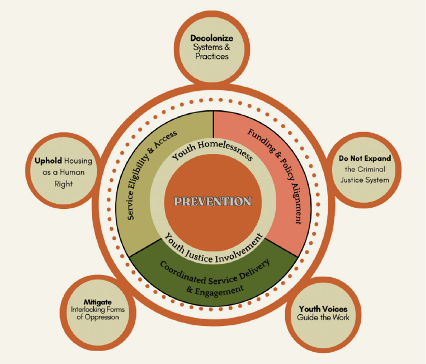Youth homelessness and youth justice don’t just overlap – they collide with one another and create repeat patterns in both systems. We don’t talk much about what happens to unhoused youth who become justice-involved, or what happens to youth who go through the youth justice system and need housing supports. These young people are arguably some of our country’s most vulnerable, and we have a responsibility to create more positive pathways to safe, healthy lives that are free from involvement in either system.
As a team of academic and sector researchers, and guided by our youth advisory group, we worked with the National Youth Justice Network (NYJN) to explore the intersection of the youth homelessness and youth justice sectors through a solutions-oriented framework, seeking to improve our understanding of:
- How the youth justice system can reduce young people being discharged into homelessness, and,
- How the youth homelessness sector can support rapid and sustainable exits from homelessness to prevent youth from (further) involvement in the justice system.
We spoke with key actors in the youth justice and youth homelessness sectors to better understand the challenges youth are facing, and most importantly, what we can do about it. We’ve published the results of this work, which provides findings related to the project’s 3 strategic problem areas:
- Service Eligibility and Access
- Funding and Policy Alignment
- Coordinated Service Delivery and Engagement
The challenges for youth experiencing both homelessness and justice system involvement stem from structural inequities, system failures, and power imbalances that directly lead to the marginalization and discrimination of young people in Canada. Clear guiding principles emerged that first need to be engaged with before addressing solutions:

Through our solutions-oriented exercises, we identified 14 overarching solutions to address the intersection of youth homelessness and youth justice involvement:
I. Service Eligibility & Access
-
Enable early and comprehensive discharge planning from youth justice systems.
-
Empower service providers to respond with urgency when youth are at risk.
-
Establish a consistent definition of youth across sectors to streamline support.
-
Enhance or create services specifically for rural and remote communities.
II. Funding & Policy Alignment
-
Increase flexibility in funding, including discretionary funds and eligibility criteria.
-
Improve compensation and training for frontline staff.
-
Foster cross-sectoral collaboration at the community level.
-
Design funding frameworks that assess access from a youth-centered perspective.
-
Promote cross-jurisdictional collaboration between provincial/territorial and federal ministries.
-
Ensure Indigenous equity and autonomy in funding decisions and delivery.
III. Coordinated Service Delivery & Engagement
-
Offer culturally appropriate services tailored to youth needs.
-
Simplify system navigation by streamlining policies and practices.
-
Strengthen youth attachment to their community and natural support networks.
-
Prioritize individualized service plans—because one size does not fit all.
Each of these solutions contains multiple ‘Pathways for Changemakers’ to initiate or advance progress that can serve as a roadmap for those who are looking to implement them. In total, 120 pathways were identified by the stakeholders of this project, directed at federal, provincial/territorial, and municipal governments, and community-based agencies.
The pathways for the federal government are promising because Canada already has access to legislative tools like the Youth Criminal Justice Act and the National Housing Strategy Act to address gaps in preventing youth homelessness and youth justice involvement. These Acts can be bolstered by other initiatives (i.e., Truth and Reconciliation Commission’s Calls to Action, Canada’s Black Justice Strategy, Federal Framework to Reduce Recidivism). As the gatekeepers for policy implementation and investment, pathways for provincial and territorial governments must engage with their federal and municipal counterparts while also actively collaborating with community-based agencies to understand unique regional contexts and implement local solutions.
At a more local level, pathways for municipal governments offer inspiration to take on a more significant role to having community-informed approaches that will help municipalities advocate with their government counterparts, and to make more informed investments in safe, affordable housing options for youth aging out of these systems. Finally, community-based agencies are at the heart of the connection between youth justice involvement and youth homelessness. The pathways for them are grounded in enhancing/implementing processes that prioritize person-centred approaches, collaborating across sectors, and engaging with multiple levels of government to communicate the needs of the youth accessing their services and the staff who support them.
Collectively, the Pursuing Justice project’s findings, and particularly the 120 ‘Pathways for Changemakers’, strive to empower decision-makers across the youth justice and youth homelessness systems to actively pursue steps towards meaningful change.
Read the full report here.
